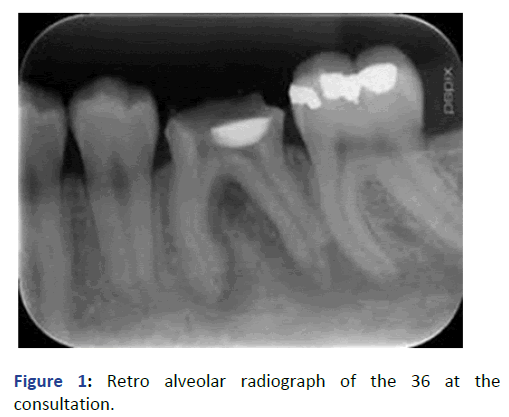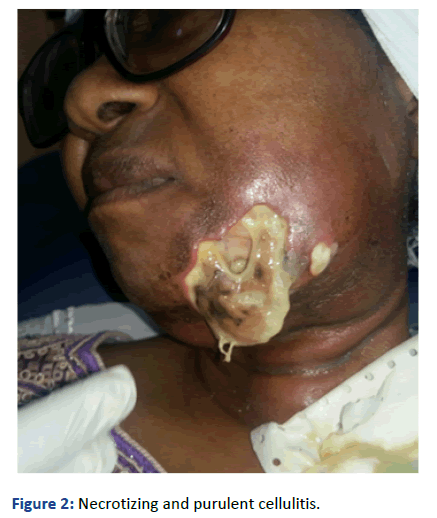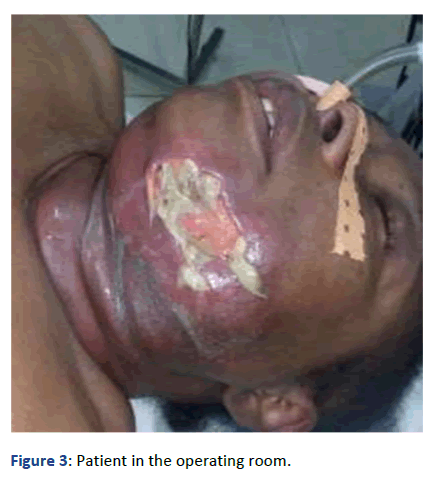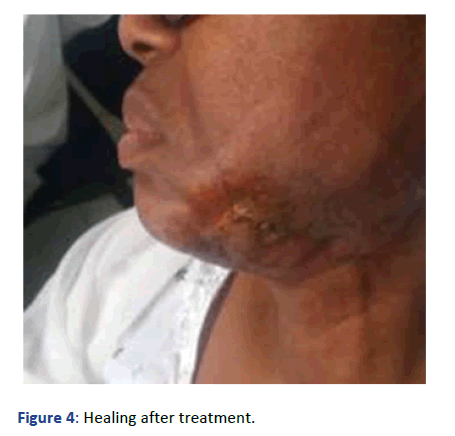Case Report - (2023) Volume 7, Issue 2
Received: 22-Oct-2022, Manuscript No. IPOM-22-14577; Editor assigned: 24-Oct-2022, Pre QC No. IPOM-22-14577 (PQ); Reviewed: 07-Nov-2022, QC No. IPOM-22-14577; Revised: 19-Apr-2023, Manuscript No. IPOM-22-14577 (R); Published: 26-Apr-2023, DOI: 10.36648/IPOM.7.2.18
Cervicofacial cellulitis of dental origin is a serious and dreadful condition that poses a serious problem of therapeutic management. These infrequent complications of dental caries can be life threatening and constitute a real public health problem. Most often, these cellulites occur either as a result of inappropriate initial management or on a weakened site. This is a case report of a 55-year-old female diabetic patient who came to the clinic for recurrent spontaneous and provoked odontalgia, located on the left mandibular first molar for more than a year. The general condition of our patient at the first consultation was apparently good. Her history was diabetes and hypertension not followed up. It is therefore necessary to prohibit any prescription of non-steroidal anti-inflammatory drugs, especially as immunotherapy in cases of cervico-facial infections of dental origin in diabetic patients.
Dental infection; Diabetes; Anti-inflammatory drugs; Cervicofacial cellulitis
Cervicofacial cellulitis of dental origin is a serious and dreadful condition that poses a serious problem of therapeutic management. These infrequent complications of dental caries can be life threatening and constitute a real public health problem. Most often, these cellulites occur either as a result of inappropriate initial management or on a weakened site. This work presents the explosive cocktail of "dental infection, unbalanced diabetes and anti-inflammatory drugs" and describes the rapidity of the occurrence of necrotizing cellulitis through a clinical case and discusses the use of NSAIDs in odontostomatology [1].
This is a case report of a 55-year-old female diabetic patient who came to the clinic for recurrent spontaneous and provoked odontalgia, located on the left mandibular first molar for more than a year. The general condition of our patient at the first consultation was apparently good. Her history was diabetes and hypertension not followed up. The clinical examination showed a carious 36 with provoked and spontaneous odontalgia, palpation of the vestibule was painful as well as axial and transverse percussions. Retro alveolar radiological examination of the tooth shows radiolucent periapical images and furcation involvement [2]. The infectious dental periapical complication is evoked and the diagnosis of acute apical periodontitis is made (Figure 1).

Figure 1: Retro alveolar radiograph of the 36 at the consultation.
Our attitude was to relieve the patient with the prescription of level 2 analgesics, a probabilistic antibiotic therapy, an antiseptic in mouthwash and the patient was referred to her attending physician in order to balance her glycemia and hypertension. We saw the patient again one week later with a clinical picture marked by an alteration of the general state, hyperthermia at 39°, asymmetry of the swollen left hemi-face, and a left purulent maxillofacial tissue necrosis of great extent with a weak trismus (Figure 2) [3-6].

Figure 2: Necrotizing and purulent cellulitis.
After a brief questioning, we note the use of non-steroidal anti-inflammatory drugs prescribed by his attending physician in view of the presence of the hard, woody and painful jugal swelling. Moreover, the diabetic balance is unbalanced with a capillary glycemia at 1.8 g/l and glycosylated hemoglobin at 8%. The therapeutic procedure in front of this clinical picture is established: emergency hospitalization, excision of the necrotic infected areas, debridement, then drainage of the pus and extraction of the 36 under general anesthesia (Figure 3).

Figure 3: Patient in the operating room.
Parenteral medication was started with amoxicillin, metronidazole, paracetamol, antiseptic for 6 days. Medication for diabetes and hypertension was taken at the same time. The postoperative follow-up was normal but with an unsightly scars (Figure 4) [7].

Figure 4: Healing after treatment.
Diffuse cervico-facial cellulitis of dental origin still seems to be frequent in our departments. Gadegbeku et al. already in 1995 reported a frequency of 11 % in a retrospective study of severe maxillofacial cellulitis and phlegmons in the African environment in the stomatology department of Abidjan. Late consultations, self-medication, HIV infection, diabetes, malaria, inadequate oral health infrastructure, traditional practices, and impoverishment are the causes cited by various authors. These causes can be isolated or associated. Thus Ouattara et al. noted in 1998 a frequency of 21.4% of severe maxillofacial cellulitis related to HIV infection. In our clinical case, there were three contributing factors (unbalanced diabetes, inappropriate prescription of anti-inflammatory drugs and oral infection). The use of non-steroidal antiinflammatory drugs in oral surgery in adults has been recommended by the French-speaking Society of Oral Surgery (SFCO) since 2008 and indicates that an appropriate antibiotic should be prescribed concomitantly. Concerning the causal tooth, it is the infection of the lower first molar that is evoked. This high frequency of lower molar lesions has also been found by several authors as mandibular teeth are more susceptible to dental caries than their maxillary counterparts. In addition, oral infections can influence glycemic control and insulin resistance and are often associated with an increased risk of diabetic complications. The susceptibility of diabetics to bacterial infections, probably secondary to certain functional abnormalities of leukocytes following hyperglycemia, would be manifested by the tendency to be more severe than in normal subjects. Glycemic control and diabetic balance are therefore essential for good ontological management of diabetic subjects. Diabetes in Cote d'Ivoire affects 6.2% of the Ivorian population, i.e. more than 1.3 million people. It is also necessary to add the diabetics who are unaware of their condition and who are numerous in our developing countries where there are still difficulties of access to primary health care. (It is very important to know about this disease whose prevalence is constantly increasing. The fasting blood glucose level of a healthy person is less than 1.10 g/l or 5.5 mmol/l and in diabetic subjects it is more than 1.26 g/l. The subject's energy homeostasis is therefore disturbed and can be modified by endocrine, nervous and metabolic factors. The goal is to maintain a glycated hemoglobin level below 7% to obtain balanced diabetes. The bidirectional link between diabetes and oral infections has been widely demonstrated in the scientific literature. It is known that diabetes influences oral pathologies and vice versa. Diabetes is a major risk factor for oral diseases. In our case, the patient had unbalanced diabetes and was at risk for severe oral infectious consequences. The same is true for other serious general pathologies that may occur: Cardiovascular, ocular, nervous and renal diseases. The many infectious complications of diabetes are influenced by two factors: Glycemic control and the virulence of the oral disease pathogens [8-10].
Thus the oral cavity of the diabetic subject may be marked by:
• An increase in the incidence and severity of periodontal
and gum disease.
• A xerostomia (dry mouth) caused by the decrease of all
salivary components.
• An increase in the risk of caries due to xerostomia and the
modification of the oral flora responsible for polycaries.
• An increase in the risk of bacterial, viral and fungal
infections due to a disturbance of the leucocyte functions
creating an immunodepression.
• An alteration of taste following the intake of glucophage.
• An appearance of dry lips, with cracks, cheilitis, and a
tongue with hypertrophied or atrophied fungiform
papillae, or in the presence of glossodynia.
Lesions of the oral mucosa: Erythema, lichen planus, candidiasis, ulcerations (Aphthae)
Regarding the treatment of diabetes, the key is self-monitoring of blood sugar, physical activity and diet. Our patient did not follow her treatment correctly, hence the need for blood glucose monitoring, either by regular control of her fasting blood glucose and every 3 months by her glycated Hemoglobin (HbA1c). In the management of diabetes, it is necessary in the framework of the "One Healh." that the dialectologist has the easy tongue depressor to examine the oral cavity of his patient and the dental surgeon to carry out the capillary glycemia in the dental office (Table 1).
| HbA1c (%) | Mean plasma glucose (g/L) |
|---|---|
| 4 | 0.65 |
| 5 | 1.00 |
| 6 | 1.2 |
| 7 | 1.5 |
| 8 | 1.8 |
| 9 | 2.10 |
| 10 | 2.4 |
Table 1: Correlation between average blood glucose levels and HbA1c value.
The most obvious common risk factor between diabetes and oral disease is no steroidal anti-inflammatory drugs. Thus, non-steroidal anti-inflammatory drugs used in this case have caused an explosive infectious flare. Their use is prohibited in cellulitis of dental origin because of the danger of the antiinflammatory effect, particularly in blocking the production of prostaglandins. Moreover, various authors have pointed out that their administration is a factor that increases the severity of dental cellulitis. The prescription of anti-inflammatory drugs in our case was only to treat the pain and the jugal inflammation while hiding the diabetes and the underlying dental infection and in the absence of an effective and adapted antibiotic. The NSAID, by its depressive effect on the humoral mechanisms of immune defense against the infection, masked or diminished the symptomatology while favoring the severity and diffusion of the infection. The combination of amoxicillin/clavulanic acid or amoxicillin associated with metronidazole has been shown to be effective in cellulitis, but this probabilistic choice must subsequently be adapted according to the antibiogram. The antibiogram performed in the clinical case treated in the operating room was compatible with this prescription [11,12].
Diffuse cervico-facial cellulitis of dental origin, in spite of current therapeutic progress, remains a serious pathology that is still frequent and fatal in our developing countries. Therefore, raising awareness of NSAIDs as an aggravating factor of these cervico-facial cellulitis among the population and certain physicians is still a priority action in order to avoid certain complications such as those that occurred in the case presented here, whose management was multidisciplinary and relied on emergency surgery and inpatient medication. It is therefore necessary to prohibit any prescription of nonsteroidal anti-inflammatory drugs, especially as immunotherapy in cases of cervico-facial infections of dental origin in diabetic patients.
This work does not present any conflict of interest.
[Crossref] [Google Scholar] [PubMed]
[Google Scholar] [PubMed]
[Crossref] [Google Scholar] [PubMed]
Citation: Daniel A, Attogbain KP, Kouyate V, Atse K (2023) Dental Infection, Diabetes and Anti-Inflammatory Drugs: An Explosive Triad. J Ora Med. 7:170
Copyright: © 2023 Daniel A, et al. This is an open-access article distributed under the terms of the Creative Commons Attribution License, which permits unrestricted use, distribution, and reproduction in any medium, provided the original author and source are credited.